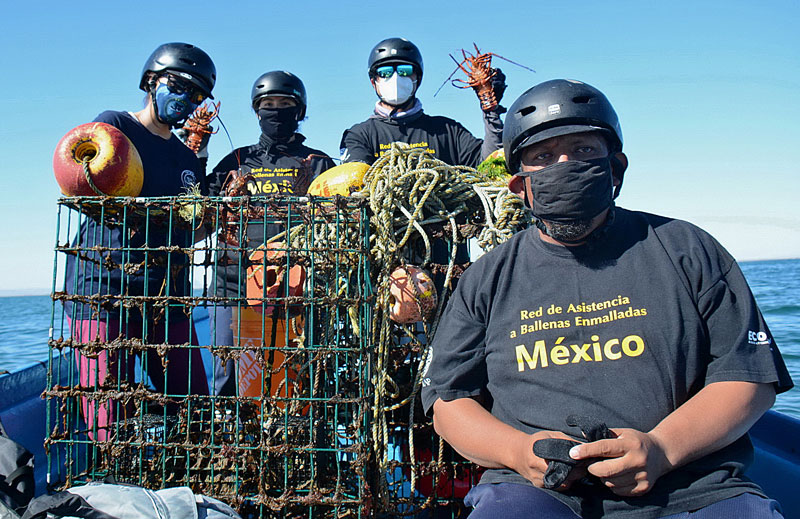Winter 2021 Annual Gray Whale Research Report for
Laguna San Ignacio and Bahía Magdalena, B.C.S., México
During the COVID-19 pandemic two research teams from the Autonomous University of Baja California Sur’s (UABCS) Marine Mammal Program (PRIMMA) in La Paz, Baja California Sur, México arrived at Laguna San Ignacio and Bahía Magdalena in mid-January 2021 to begin surveys of the gray whales to document the numbers and health of the gray whales during this 3rd year of the Unusual Mortality Event (UME) sweeping the population.
With the help of the local communities at Laguna San Ignacio and Bahía Magdalena, these researchers operated under specific isolation protocols to protect their health and safety, and to minimize the risk of becoming infected with the COVID-19 virus, and to protect the safety of the local residents of Laguna San Ignacio and Bahía Magdalena. We are grateful for the assistance they received from our community of friends.
The Bahía Magdalena team was led by Dra. Lorena Viloria Gómora and included Daniela Bernot Simon, Omar Castañeda García, Mario Marquéz Segovia, Lorena Citlalli Magallón Flores, Omar Flores Ramírez, Michelle Rosales India, and Captain Miguel Gómez. In Laguna San Ignacio Dr. Sergio Martínez A. worked with researchers Floryser Ronzón-Contreras, Minerva Valerio, Alejandra Saavedra, and Andrés González. The UAV-Drones were piloted by Fabian Rodríguez-González in Laguna San Ignacio.
In our 2021 Annual Research Report we describe:
* The abundance of gray whales throughout the 3 month 2021 winter breeding season, especially the third consecutive year of very few female-calf pairs. ** Learn more about how we count gray whales in the breeding lagoons in Baja California Sur, Mexico **
* The increased proportion of “skinny” whales and evaluation of gray whale body condition during the Unusual Mortality Event (UME)
* The unusually high number of stranded dead adult whales in all of the gray whale winter breeding and aggregation areas.
* UAV-Drone photogrammetry documents the “poor” body condition of some gray whales, and their attempts to find food in Laguna San Ignacio.
* The successful rescue and disentanglement of the 7th gray whale calf in Laguna San Ignacio.
* The photographic capture documenting three Western North Pacific gray whales that migrated with the Eastern North Pacific population to Baja California during the winter breeding season.
* More new cetacean species that are frequenting Laguna San Ignacio and Bahía Magdalena during the winter months.
YOU CAN MAKE IT HAPPEN: We are grateful to our family of sponsors whose generous support each year allows the laguna San Ignacio Ecosystem Science Program to conduct research on gray whales and their lagoon aggregation and breeding areas in Baja California. We urge you to consider becoming a supporter of our program by making a monthly donation through our fiscal sponsor The Ocean Foundation. Setting up your monthly donations is safe and secure at the following link: https://www.sanignaciograywhales.org/donate/. Thank You!
TAKE A LOOK AT THESE RECENT PUBLICATIONS RELEVANT TO NORTH EASTERN PACIFIC GRAY WHALES:
Christiansen, F., et al. (2021). Poor body condition associated with an unusual mortality event in gray whales. Marine Ecology Progress Series Vol. 658:237-252.
Huntington, et al. (2020). Evidence suggests potential transformation of the Pacific Arctic ecosystem in underway. Natural Climate Change.
Martínez-Aguilar, S., Casanovas-Gamba,P., Farriols-García, M., González-Cisneros, A., Heaven, J.D., Castillo-Romero, F., Zaragoza-Aguilar, G.A., Rivera-Rodríguez, J., Mariano-Meléndez, E., López-Paz, N., Huerta-Patiño, R., Swartz, S., Viloria-Gómora, L. and Urbán R., J. (2021). Gray whale stranding records in Mexico during the 2021 winter breeding season. Report to the International Whaling Commission, SC/68C/CMP11.
Martínez A., S., Swartz, S., Urbán R., J., Ronzón, F., González, A., Valerio, M., Saavedra, A., and Rodríguez, F. (2021). Informe de las actividades del Monitoreo de la Ballena Gris (Eschrichtius robustus) temporada Invernal 2021. Laguna San Ignacio, B.C.S. México. Laguna San Ignacio Ecosystem Science Program.
Ronzón-Contreras, F., Martínez-Aguilar, S., Swartz, S., and Urbán R, J. (2021). Gray whales body condition in Laguna San Ignacio, BCS, Mexico, during 2021 breeding season. Report to the International Whaling Commission, SC/68C/CMP12.
Silber, G. K., et al. (2021). Co-occurrence of gray whales and vessel traffic in the North Pacific. Endangered Species Research. Vol. 44:177-201.
Stewart, J.D. and Weller, D.W. (2021). Abundance of Eastern North Pacific gray whales 2019/2020. NOAA Technical Memorandum NOAA-TM-NMFS-SWFSC-639, https://repository.library.noaa.gov/view/noaa/27928
Urban, et al. (In Press) Migratory behavior of an Eastern North Pacific gray whale from Baja California Sur to Chirikov Basin, Alaska. Frontiers Online Publication.
Urbán R., J.1, Swartz, S.L.2, Martínez A, S.1, and Viloria G., L.1, and Ronzón-Contreras, F. (2021). 2021 gray whale abundance in Laguna San Ignacio and Bahía Magdalena, Baja California Sur, Mexico. Report to the International Whaling Commission, SC/68C/CMP11.
Viloria Gómora L., Omar Castañeda G, Mario Márquez S., Swartz, S. and Urbán R., J. (2021). Reporte de investigación del monitoreo de ballena gris en su estancia invernal en el complejo lagunar Bahía Almejas, Bahía Magdalena, y Canal de Santo Domingo 2021. Laguna San Ignacio Ecosystem Science Program.
Share this post:




